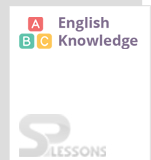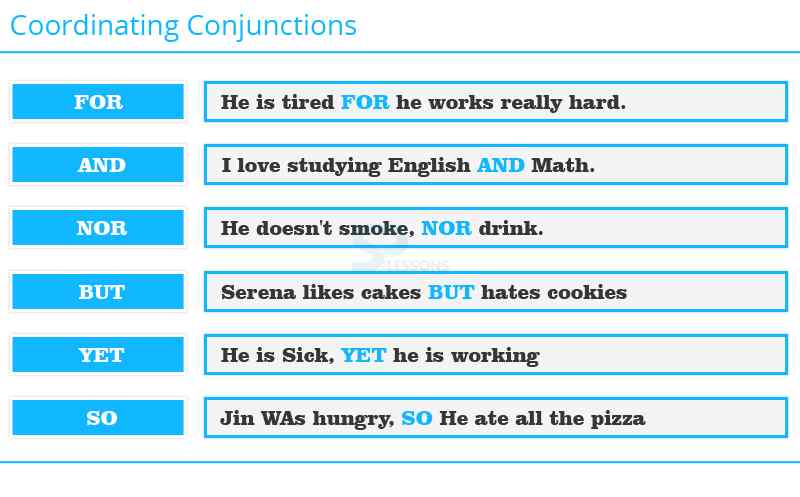 Introduction
Introduction
Words which are used to join the various other words and phrases of the sentence are called Conjunctions. Writing various sentences can confuse the reader reading the sentence. So conjunctions help in avoiding that confusion.
Conjunctions are also called linking words. For example: and, or, but, because, for, nor, so yet etc.
- Shilpa and Sheena are going to the market.
- Daughter is taking the glass of milk for her brother.
- The results are not out yet.
 Types
Types
Types of Conjunctions:
There are three main categories of conjunctions which are coordinating conjunctions, subordinating conjunctions and correlative conjunctions.
1. Coordinating Conjunctions:
Words that are used to join two or more words, phrases and clauses are called Coordinating Conjunctions. There are only seven coordinating conjunctions used. These are for, and, nor, but, or, yet, so. These can be remembered with a mnemonic i.e. F (for) A (and) N (nor) B (but) O (or) Y (yet).
For example:
2. Subordinating Conjunctions:
The words which help in linking two groups of words by making them into one clause are called Subordinating Conjunctions. These conjunctions basically join a subordinate clause and a main clause.
For example:
Following are some examples of Subordinating Conjunctions.
Correlative Conjunctions:
Conjunctions which are made up of two words and help in linking the words, phrases and clauses which have supportive relationship are called Correlative Conjunctions. Common correlative conjunctions which are used are either-or, neither-nor, whether-or, both-and, not only-but also etc.
Correlative conjunctions have been further exemplified through the below table.
- I would have a pizza for dinner.
- Ben and Tim are brothers.
- Jenny did not have the time but she managed to finish the assignment.
- The date sheet for boards is not out yet.
| Linking Individual Words | Linking Phrases | Linking Clauses |
|---|---|---|
| Pallavi, Surbhi and Tina decided to meet at the ground. | The head or his junior from Egypt will inform you the deadline of the report. | You must try hard or you won’t clear the test. |
| It is a small but a very neat room. | Her assistance or manager would answer the call. | They went to the museum and had amazing day. |
| John and George were up all night practicing guitar. | I wanted to go to the beach or for a long walk. | I liked the new phone but could not afford to buy it. |
- You will clear the exam provided that you study hard for it.
- He helps his friends whenever they need it.
- It makes me sad when you cry.
- If you do not wear a raincoat, you will get ill.
- He did not tell me the secret even when he was forced.
- All the stores had offer discounts because of the festive season.
| after | if | though |
| although | In order that | unless |
| as | Now that | until |
| because | once | when |
| before | since | whenever |
| Even if | So that | where |
| Even though | than | wherever |
| how | that | while |
- He may either purchase a car or a flat for his family.
- Both blue and black are my favorite colors.
- She is not only interested in athletics but also dancing.
- Neither Suresh nor Ramesh is to be blamed.
- She will either take cold drink or a cup of coffee.
| both…and | just as…so |
| either…or | the…the |
| neither…nor | as…as |
| not only…but also | as much…as |
| so…as | no sooner…than |
| whether…or | rather…than |
| Correlative Conjunctions | Examples |
|---|---|
| Either...or | You either do your work or prepare for a trip to the office. |
| not only...but also | Not only is he handsome, but he is also brilliant. |
| neither...nor | Neither the basketball team nor the football team is doing well. |
| both...and | Both the cross country team and the swimming team are doing well. |
| whether...or | Whether you stay or go is your decision. |
| just as...so | Just as many Americans love football, so many Canadians love ice hockey. |
| Sl.No | Conjuctions of Time | Conjuctions of Order | Conjuctions of Cause and effect |
|---|---|---|---|
| 1. | before | next | because |
| 2. | after | lastly | since |
| 3. | until | firstly | as |
| 4. | since | before | for |
| 5. | when | in addition | yet |
| 6. | while | finally | therefore |
| 7. | Finally | ||
| 8. | at the same time | ||
| Ex: | Finish the Project while you have time. | Leila doesn't need anew bag and secondly, she doesn't want one. | I bought the book because I need it. |
 Rules
Rules
Rule 1: When in a sentence ‘and’ is being used, it should always be preceded by the conjunction ‘both’.
For example:
- She looks beautiful in both red and pink dress.
- He will be studying both English and Hindi as his main subjects.
- You do not sing so well as your sister.
- He is as good as the rest of his classmates.
- Though he tried hard, he still could not finish the project on time.
- Although the notes are very much, still the students copy them to study for the exams.
- No sooner did I step out then it started to rain.
- Hardly had I stepped out of my bed before having lunch.
- Barely had he got his new phone before it was stolen.
- Take an umbrella with you lest it should rain.
- Wait here until your parents work.
- Unless you study hard, you will not succeed in life.
- I doubt if they will attend the wedding ceremony. (This is a negative sentence.)
- I do not doubt that he will be able to climb up the rope. (This is an affirmative sentence.)
- He let down not only his parents but also his best friend.
- You have to choose between politics and geography.
- My sister keeps dancing from morning to evening.
- None of his relatives came forward to help his family.
- One of your siblings is responsible for the damage done to the car.
- The local channel seldom or never telecasts good movies.
- She has no other choice than to go for higher education.
- I would rather read a novel than go and party in a club.
- Rita walked her dog, so she got the loaf of bread.
- I want to go see the play, but my brother has my scooter.
- Alia loves parrots, yet she does not want one in her own house.
- My father likes guavas and mangoes.
- My sister is old but foolish.
- She is cooking dal, making chapattis, listening to songs and talking to mother in the kitchen. (This was without the coma.)
- She is cooking dal, making chapattis, listening to songs, and talking to mother in the kitchen. (This was with the use of coma.)
| Rules | Special Words | Sentences |
|---|---|---|
| Rule 1: Subordinate Conjunctions | If, when, because, although and all the same words. | Because I like teaching, I am considering a teaching career. |
| Rule 2: Coordinate Cconjunctions | For, although, nor, but, or, yet, so | I suggested movie, but everyone else wanted a disco night. |
| Rule 3: Interrupters | Who and which | Tina who joined the team just now, will be the captain next year. |
 Errors
Errors
Following are some errors which are usually committed by people while using Conjunctions.
Incorrect: By the time we reached the venue then everybody was left.
Correct: By the time we reached the venue, everybody had left.
Incorrect: The teacher asked me that why I was late.
Correct: The teacher asked me why I was late.
Incorrect: No sooner she has reached the railway station the train left.
Correct: No sooner did she reach the railway station than the train left.
Incorrect: Not only he insulted her but also slapped her.
Correct: Not only did he insult her but he also slapped her.
Incorrect: unless you do not study, you will never clear the test.
Correct: Unless you try, you will never clear the test.
Incorrect: There is no such novel which you told me.
Correct: There is no such novel as you told me.
Incorrect: my friend suggested me certain genres such that fantasy fiction, thriller and non-fiction.
Correct: My friend suggested my certain genres like fantasy fiction, thriller and non-fiction.
Hope that the article is clear to you and now you can enjoy using conjunctions confidently in day 2 day life.










